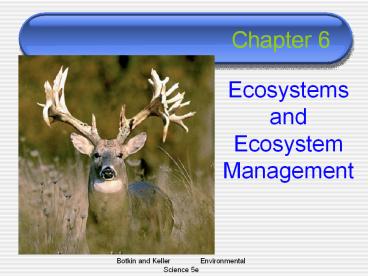Ecosystems and Ecosystem Management - PowerPoint PPT Presentation
Title:
Ecosystems and Ecosystem Management
Description:
Title: Chapter 6 Author: NYorio Last modified by: San Diego City Schools Created Date: 8/29/2005 4:15:15 PM Document presentation format: On-screen Show (4:3) – PowerPoint PPT presentation
Number of Views:549
Avg rating:3.0/5.0
Title: Ecosystems and Ecosystem Management
1
Chapter 6
- Ecosystems and Ecosystem Management
2
Basic Characteristics of Ecosystems
- Sustained life on Earth is a characteristic of
ecosystems, not of individual organisms or
populations- no member of a community can carry
out the processes of life alone - Structure An ecosystem is made up of two major
parts - Non-Living (Abiotic)- Physical Environment (Soil,
Air and Water) - Living (Biotic)- Ecological community
3
Basic Characteristics of Ecosystems
- 2) Processes Two basic kinds of processes must
occur in an ecosystem a cycling of chemical
elements and a flow of energy - 3) Change An ecosystem changes over time and can
undergo development through a process called
succession
4
Ecological Communities and Food Chains
- Ecological Communities
- A set of interacting species that occur in the
same place and function together to make possible
the persistence of life - Energy, chemical elements and some compounds are
transferred from creature to creature along FOOD
CHAINS/FOOD WEBS (Linkage of who feeds on whom)
5
Trophic Levels
- A trophic level consists of all those organisms
in a food web that are the same number of feeding
levels away from the original source of energy. - The original source of energy in most ecosystems
is The Sun.
6
Food Chains and Food Webs
- A Terrestrial Food Chain
- 4 trophic levels
- Autotrophs (Photosynthesizing plants, algae and
bacteria) - Herbivores (Plant-Eaters)
- Carnivores (Feed directly on Herbivores)
- Carnivores (Feed on other Carnivores) and
Decomposers (Bacteria and Fungi-Feed on
everything) - People are Omnivores (Herbivore Carnivore)
7
(No Transcript)
8
(No Transcript)
9
The Community Effect
- Species interact directly and indirectly
- Community-level interactions
- Example Sea Otters of Pacific Ocean
- Otters eat Sea Urchins
- Sea Urchins eat kelp (important habitat for many
creatures) - More Sea Otters Less Sea Urchins More Kelp
Forests for many sea creatures
10
Keystone Species
- A species such as the Sea Otter that has a large
effect on its community or ecosystem is called a
Keystone Species - Removal or change in the role of a keystone
species within the ecosystem changes the basic
nature of the community
11
Community Interactions with Sea Otter
12
Oceanic Food Web
13
Food Web of Harp Seal
14
Natural and Artificial Ecosystems
- Ecosystems can be natural or artificial or a
combination of both - Agriculture can be thought of as partial
management of certain kinds of ecosystems - Wildlife Preserves are examples of partially
managed ecosystems
15
Review Questions
- 1) What is the difference between an ecosystem
and an ecological community? - 2) In what ways would an increase in the number
of sea otters and a change in their geographical
distribution benefit fisherman? In what ways
would these changes be a problem for fisherman?
16
Review Questions
- 3) Based on the discussion in this chapter, would
you expect a highly polluted ecosystem to have
many species or few species? - 4) Is our species a keystone species? Explain.































